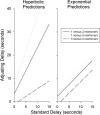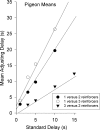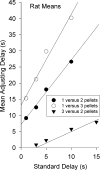Delay-amount tradeoffs in choices by pigeons and rats: hyperbolic versus exponential discounting
- PMID: 19794834
- PMCID: PMC2648524
- DOI: 10.1901/jeab.2009.91-197
Delay-amount tradeoffs in choices by pigeons and rats: hyperbolic versus exponential discounting
Abstract
An adjusting-delay procedure was used to study the choices of pigeons and rats when both delay and amount of reinforcement were varied. In different conditions, the choice alternatives included one versus two reinforcers, one versus three reinforcers, and three versus two reinforcers. The delay to one alternative (the standard alternative) was kept constant in a condition, and the delay to the other (the adjusting alternative) was increased or decreased many times a session so as to estimate an indifference point--a delay at which the two alternatives were chosen about equally often. Indifference functions were constructed by plotting the adjusting delay as a function of the standard delay for each pair of reinforcer amounts. The experiments were designed to test the prediction of a hyperbolic decay equation that the slopes of the indifference functions should increase as the ratio of the two reinforcer amounts increased. Consistent with the hyperbolic equation, the slopes of the indifference functions depended on the ratios of the two reinforcer amounts for both pigeons and rats. These results were not compatible with an exponential decay equation, which predicts slopes of 1 regardless of the reinforcer amounts. Combined with other data, these findings provide further evidence that delay discounting is well described by a hyperbolic equation for both species, but not by an exponential equation. Quantitative differences in the y-intercepts of the indifference functions from the two species suggested that the rate at which reinforcer strength decreases with increasing delay may be four or five times slower for rats than for pigeons.
Keywords: exponential discounting; hyperbolic discounting; keypeck; lever press; pigeons; rats; reinforcer amount; reinforcer delay; self-control.
Figures





Similar articles
-
Effects of time between trials on rats' and pigeons' choices with probabilistic delayed reinforcers.J Exp Anal Behav. 2011 Jan;95(1):41-56. doi: 10.1901/jeab.2011.95-41. J Exp Anal Behav. 2011. PMID: 21541170 Free PMC article.
-
Effects of pre-trial response requirements on self-control choices by rats and pigeons.J Exp Anal Behav. 2012 Mar;97(2):215-30. doi: 10.1901/jeab.2012.97-215. J Exp Anal Behav. 2012. PMID: 22389527 Free PMC article.
-
Rats' choices between one and two delayed reinforcers.Learn Behav. 2007 Aug;35(3):169-76. doi: 10.3758/bf03193052. Learn Behav. 2007. PMID: 17918422 Free PMC article.
-
Pigeons' delay discounting functions established using a concurrent-chains procedure.J Exp Anal Behav. 2014 Sep;102(2):151-61. doi: 10.1002/jeab.97. Epub 2014 Jul 5. J Exp Anal Behav. 2014. PMID: 25044322 Free PMC article.
-
Delay discounting of qualitatively different reinforcers in rats.J Exp Anal Behav. 2010 Mar;93(2):171-84. doi: 10.1901/jeab.2010.93-171. J Exp Anal Behav. 2010. PMID: 20885809 Free PMC article.
Cited by
-
Rats value time differently on equivalent foraging and delay-discounting tasks.J Exp Psychol Gen. 2016 Sep;145(9):1093-101. doi: 10.1037/xge0000196. Epub 2016 Jun 30. J Exp Psychol Gen. 2016. PMID: 27359127 Free PMC article.
-
Effects of time between trials on rats' and pigeons' choices with probabilistic delayed reinforcers.J Exp Anal Behav. 2011 Jan;95(1):41-56. doi: 10.1901/jeab.2011.95-41. J Exp Anal Behav. 2011. PMID: 21541170 Free PMC article.
-
Effect of orbitofrontal cortex lesions on temporal discounting in rats.Behav Brain Res. 2013 May 15;245:22-8. doi: 10.1016/j.bbr.2013.02.014. Epub 2013 Feb 20. Behav Brain Res. 2013. PMID: 23434604 Free PMC article.
-
Effects of pre-trial response requirements on self-control choices by rats and pigeons.J Exp Anal Behav. 2012 Mar;97(2):215-30. doi: 10.1901/jeab.2012.97-215. J Exp Anal Behav. 2012. PMID: 22389527 Free PMC article.
-
Nucleus accumbens and delay discounting in rats: evidence from a new quantitative protocol for analysing inter-temporal choice.Psychopharmacology (Berl). 2012 Jan;219(2):271-83. doi: 10.1007/s00213-011-2459-1. Epub 2011 Sep 6. Psychopharmacology (Berl). 2012. PMID: 21894486
References
-
- Bickel W.K, Odum A.L, Madden G.J. Impulsivity and cigarette smoking: Delay discounting in current, never, and ex-smokers. Psychopharmacology. 1999;146:447–454. - PubMed
-
- Green L, Fry A.F, Myerson J. Discounting of delayed rewards: A life-span comparison. Psychological Science. 1994;5:33–36.
Publication types
MeSH terms
Grants and funding
LinkOut - more resources
Full Text Sources

